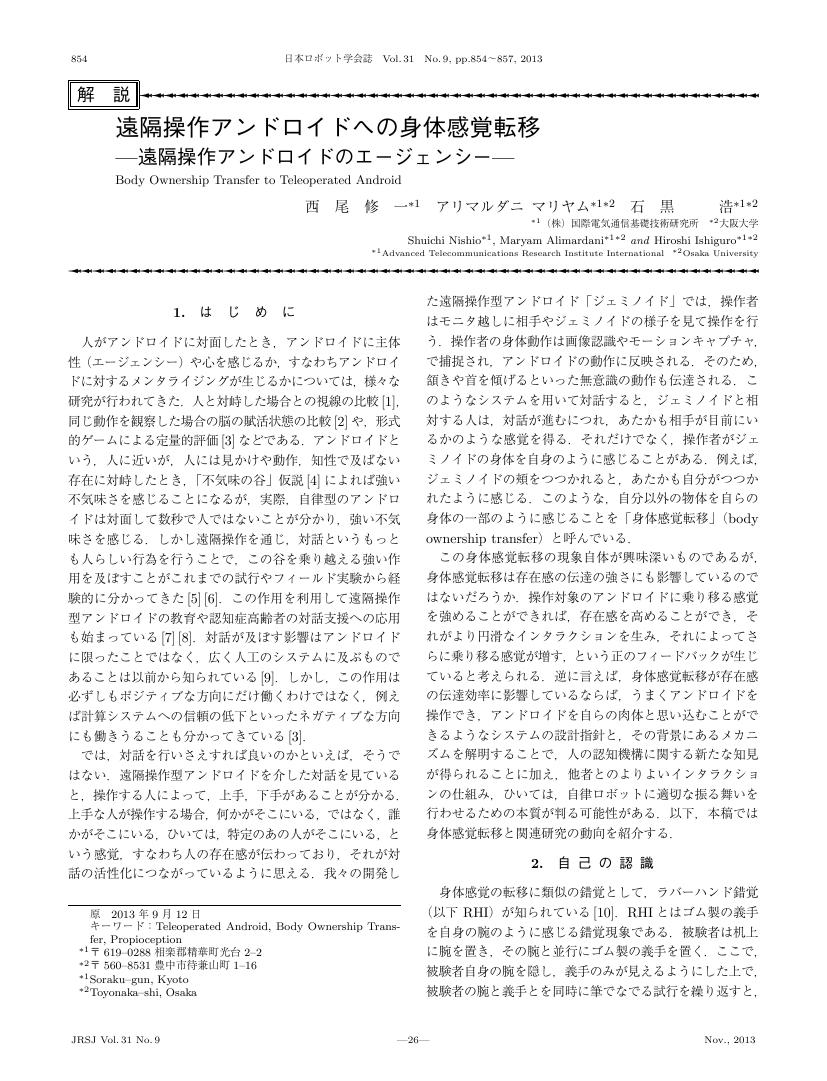7 0 0 0 演歌の歌詞における笑い表現の定量的評価
- 著者
- 中村 亨 小山 謙二 西尾 修一
- 出版者
- 一般社団法人情報処理学会
- 雑誌
- 情報処理学会研究報告人文科学とコンピュータ(CH) (ISSN:09196072)
- 巻号頁・発行日
- vol.1996, no.73, pp.25-32, 1996-07-26
- 被引用文献数
- 2
円滑なコミュニケーションにとって重要な役割を果たすと考えられる「笑い」に注目し,様々な面からの分析を行っている.今回,大衆的,情緒的なメディアの代表例である歌謡曲を取り上げ,歌詞に含まれる笑いの記述(笑い表現)の調査,分析を行った.対象とした人気歌謡曲1423曲を,演歌系とPOPS系(演歌系以外)の歌謡曲に分類し,笑い表現の出現傾向の比較を行った.対象曲の歌詞から抜き出した各笑い表現を,快,不快,社交の3つの基本的な笑いの要素から構成されるものと考え,その割合をみた.さらに笑い手や語り手など人間関係,笑い手の気持ち,時制などを調べた.また,笑いと対照的な感情表現として泣きの記述についても出現傾向を調べた.This paper reports an analysis of laughs expressed in lyrics of Japanese popular songs. Expressions describing laugh were extracted from lyrics of 1423 songs. Each song was classified as either "Enka" (a popular song with a traditional Japanese melody) or not. Differences in these two categories were investigated in various aspects. Each laugh expression was evaluated by the ratio of three fundamental components: laugh of pleasantness, unpleasantness and sociability. Furthermore, other attributes of laugh expressions, such as the human relations, the feeling of the person laughing, and the tense were also examined.
3 0 0 0 OA 遠隔操作アンドロイドへの身体感覚転移 —遠隔操作アンドロイドのエージェンシー—
- 著者
- 西尾 修一 アリマルダニ マリヤム 石黒 浩
- 出版者
- 一般社団法人 日本ロボット学会
- 雑誌
- 日本ロボット学会誌 (ISSN:02891824)
- 巻号頁・発行日
- vol.31, no.9, pp.854-857, 2013 (Released:2013-12-15)
- 参考文献数
- 18
- 被引用文献数
- 1 1
3 0 0 0 社会的存在としての遠隔操作型アンドロイドの研究
- 著者
- 石黒 浩 中村 泰 西尾 修一 宮下 敬宏 吉川 雄一郎 神田 崇行 板倉 昭二 平田 オリザ 開 一夫 石井 カルロス寿憲 小川 浩平
- 出版者
- 大阪大学
- 雑誌
- 基盤研究(A)
- 巻号頁・発行日
- 2013-04-01
人と関わるロボットの自律動作と遠隔操作の機能を統合することで,人間やロボットが存在する社会的で現実的な場面において, 発話やジェスチャーなどの社会的振る舞いを行い, 社会に参加できるロボットシステムの実現を目指すとともに, 社会的な対話の認知心理学的な理解とモデリングに取り組んだ.今年度は, 以上の取り組みを開始したところであったが, 本提案をさらに発展させた, 人間に酷似したロボットであるアンドロイドの機構の改良や BMI の導入を含む基盤研究 S "人のような存在感を持つ半自律遠隔操作型アンドロイドの研究" が採択されたため,5月31日をもって,本研究課題を廃止し, 基盤研究 S の一部として研究を推進している.本研究課題実施時の具体的な研究内容としては, 1. 対人状況における注意制御機能と遠隔操作機能の統合の一部として, 学習アルゴリズムに基づくロボットの自律制御に関する研究, 及び, 2. 社会的状況における対話の認知科学的モデル化の研究の一部として, ロボット演劇中のロボットが人にアプローチするシーンの演出データからの社会的振る舞いの抽出に取り組んだ.現在, 基盤研究 S として, 物理的なインタラクションをも自然にするための電磁リニアアクチュエータを用いたアンドロイドの開発,複数人による雑談などの具体的な社会的状況における対話とそれに伴う行動の記録と分析に基づく対話モデルの構築や, 遠隔操作の記録を基にしたアンドロイドの自律化に取り組んでおり, 今後,行う予定のブレインマシンインターフェースによる遠隔制御の導入などとともに, 人との多様な相互作用を行うアンドロイドの開発, 社会的存在としての機能の実現, 現実社会におけるアンドロイドの社会参加の実現に取り組む.
- 著者
- 渡辺 哲矢 西尾 修一 小川 浩平 石黒 浩
- 出版者
- 一般社団法人電子情報通信学会
- 雑誌
- 電子情報通信学会論文誌. D, 情報・システム (ISSN:18804535)
- 巻号頁・発行日
- vol.94, no.1, pp.86-93, 2011-01-01
- 被引用文献数
- 2
遠隔操作型アンドロイドロボットを操作する際,触覚フィードバックがないにもかかわらず,ロボットの身体に触られると自分に触られたように感じることがある.類似の現象として,身体への触覚刺激に同期して身体以外への物体に触覚刺激を与えている様子を観察させると,身体感覚の転移が生ずる「Rubber Hand Illusion」が知られているが,触覚刺激を伴わない身体感覚の転移についての研究事例は少なく,特に対象物を遠隔操作する際の転移に関する報告はこれまでない.本論文ではアンドロイドの遠隔操作時に身体感覚の転移が実際に生じているのかを検証した.その結果,アンドロイドと操作者の動きが同期した場合に,触覚刺激を与えなくても,身体感覚の転移が生ずることが分かった.
2 0 0 0 OA 遠隔操作アンドロイドによる存在感の研究
- 著者
- 渡辺 哲矢 小川 浩平 西尾 修一 石黒 浩
- 出版者
- 一般社団法人電子情報通信学会
- 雑誌
- 電子情報通信学会技術研究報告. HCS, ヒューマンコミュニケーション基礎 (ISSN:09135685)
- 巻号頁・発行日
- vol.108, no.487, pp.19-24, 2009-03-16
遠隔操作型アンドロイドを操作する際,視覚フィードバックしかないのにも関わらず,ロボットの体に触られると自分の体に触られたように感じることがある.類似の現象として,視覚刺激に同期して触覚刺激を与えると身体感覚の延長が生ずる「Rubber Hand Illusion」が知られているが,視覚刺激のみでの研究事例は少ない.そこで我々はアンドロイドの遠隔操作時の同調性を制御した被験者実験を行い,実際に錯覚が生じているのか,またはどのような条件がそろえば,そのような錯覚が生じるか検証した.その結果同調感を高めると,視覚刺激のみでも身体感覚の延長が引き起こされることがわかった.
- 著者
- 西尾 修一 アリマルダニ マリヤム 石黒 浩
- 出版者
- 一般社団法人 日本ロボット学会
- 雑誌
- 日本ロボット学会誌 (ISSN:02891824)
- 巻号頁・発行日
- vol.31, no.9, pp.854-857, 2013
- 被引用文献数
- 1
1 0 0 0 OA 笑いのメカニズムの解明に向けて
1 0 0 0 OA 遠隔操作型コミュニケーションロボットにおける頷き動作の半自律化による操作主体感への影響
- 著者
- 中道 大介 西尾 修一
- 出版者
- 一般社団法人 人工知能学会
- 雑誌
- 人工知能学会論文誌 (ISSN:13460714)
- 巻号頁・発行日
- vol.31, no.2, pp.H-F81_1-10, 2016-03-01 (Released:2016-02-18)
- 参考文献数
- 12
- 被引用文献数
- 5
Teleoperation enables us to act in remote location through operated entities such as robots or virtual agents. This advantage allows us to work in places dangerous for humans or places not designed for humans such as in volcano disaster site or in narrow maintenance pipes. However, teleoperation also has a weakness, namely, several gaps (operation interface, environment, appearance, and intentionality) among ourselves and the teleoperated entities in remote. As teleoperated robots own physical bodies different from us, teleoperation requires special interfacing systems that are usually not so intuitive. Such a system requires rather long period of training for one to become familiar with it. One possible solution for this issue is to implement semi-autonomous teleoperation (SAT) facility which combines manual operation and autonomous action. With SAT, we can teleoperate remote entities in a way suitable to the teleoperated entity and to the situation in remote with the help of autonomous action. However, there is a concern that this autonomous part of SAT may decrease operators' feeling of agency and consequently, operators may lose concentration and become less efficient. To deal with this issue, we made a hypothesis that if an autonomously generated action is sufficiently suitable to the situation, operators would feel their own agency to the generated action. In this paper, we examined this hypothesis through an experiment where participants joined a conversation using a teleoperated android robot. Here we focused on autonomous generation of nodding act and evaluated operators' agency toward the generated actions. Participants listened to a speech through the teleoperated robot with different degree of autonomous motion generation. After a series of listening, they watched video recordings taken from the speaker's view that showed the teleoperated robot in action, and evaluated their agency toward the action and the appropriateness of robot's motion toward the speaker. As a result, we found that as timing of nodding become appropriate to the conversation context, the operators kept agency to robot's motion, even when the automatically generated motion and the operator's own motion were mixed. Furthermore, the robot motion which was automatically generated was evaluated more appropriate to the conversation than the operator's own motion. In conclusion, when using semi-autonomous teleoperation, if the autonomous action is appropriate to the situation, operators are able to keep agency to operated entities' acts.
1 0 0 0 人型対話メディアにおける抱擁から生まれる好意
- 著者
- 中西 惇也 桑村 海光 港 隆史 西尾 修一 石黒 浩
- 出版者
- The Institute of Electronics, Information and Communication Engineers
- 雑誌
- 電子情報通信学会論文誌 A (ISSN:09135707)
- 巻号頁・発行日
- vol.J99-A, no.1, pp.36-44, 2016-01-01
本研究は人型対話メディアを用いた身体的相互作用が,使用者の対話相手に対する感情に与える影響を検証した.身体的相互作用として抱擁に着目し,人型対話メディアの抱擁が対話者が感じる対話相手への関心や好意を向上させるという仮説を立てた.身体的相互作用を促す仕様の対話メディアを提案し,従来の対話メディアと違い,親密な人間関係を築くサポートメディアとしての可能性を示した.
1 0 0 0 OA 人のような存在感を持つ半自律遠隔操作型アンドロイドの研究
- 著者
- 石黒 浩 平田 勝弘 小川 浩平 開 一夫 石井 カルロス寿憲 吉川 雄一郎 岩井 儀雄 西尾 修一 中村 泰 吉峰 俊樹 平田 オリザ 神田 崇行 宮下 敬宏 板倉 昭二 港 隆史 平田 雅之
- 出版者
- 大阪大学
- 雑誌
- 基盤研究(S)
- 巻号頁・発行日
- 2013-05-31
本研究は,従来の遠隔操作型アンドロイドやロボットを,さらに進化させ,今後主流になると予測される遠隔操作型ロボットの研究開発プラットフォームとして,半自律遠隔操作型アンドロイドやロボットの実現を目指した研究開発を展開した.具体的には次の課題について研究に取り組んだ.多様な相互作用が可能な半自律アンドロイドの開発.社会的存在としてのアンドロイドやロボットの機能開発.現実社会おけるアンドロイドやロボットの社会における実証実験.アンドロイドのブレインマシンインターフェース(BMI)による遠隔制御の研究.
1 0 0 0 目とロの動きの時間的差異に基づく笑いの分類規準
- 著者
- 西尾 修一 小山 謙二
- 出版者
- 一般社団法人電子情報通信学会
- 雑誌
- 電子情報通信学会論文誌. A, 基礎・境界 (ISSN:09135707)
- 巻号頁・発行日
- vol.80, no.8, pp.1316-1318, 1997-08-25
- 被引用文献数
- 31
笑いの表情の動画像を顔の3次元モデルを用いて合成して被験者に呈示し, 笑いの種別を分類させる実験を行った. この結果, 目と口の動きの開始時点の違いから笑いの種類を分類する規準を見出すことができた.
